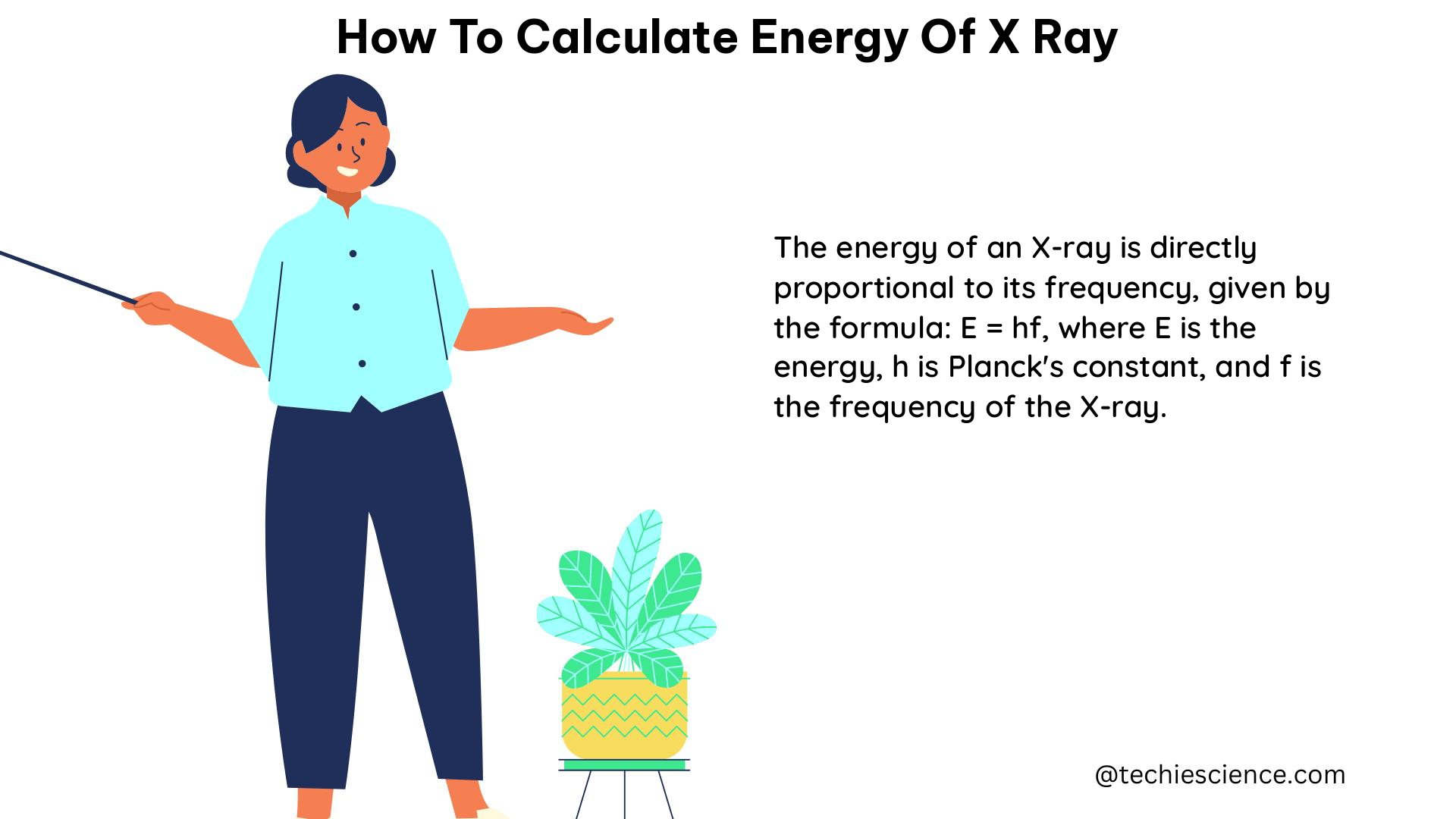Summary
Calculating the energy of X-rays is a crucial step in various fields, including materials science, medical imaging, and spectroscopy. This comprehensive guide will walk you through the fundamental principles and equations used to determine the energy of X-rays, as well as provide practical examples and numerical problems to help you master the concept.
Understanding the Photoelectric Effect

The photoelectric effect is the primary mechanism used to calculate the energy of X-rays. When an X-ray photon interacts with an atom, it can eject an electron from one of the atom’s inner shells. The energy of the ejected electron is directly related to the energy of the incident X-ray photon.
The relationship between the energy of the X-ray (E), the binding energy of the electron (ε), and the energy of the ejected electron (eV) is given by the following equation:
E = ε + eV
where:
– E is the energy of the X-ray photon
– ε is the binding energy of the electron
– eV is the energy of the ejected electron
Calculating the Energy of X-Rays using the Photoelectric Effect
To calculate the energy of an X-ray using the photoelectric effect, you can use the following equation:
i = 1.6 × 10^-19 coulomb * F * eV / ε
where:
– i is the current generated by the X-ray
– F is the rate of X-ray photons hitting the photodiode
– ε is the energy needed to form an electron-hole pair
Let’s consider an example:
Suppose you have an X-ray source with an incident beam of Ti Kα1 (4510.84 eV) X-rays, with a photon intensity of 2 × 10^5 photons·cm^-2·s^-1, and a silicon photodiode with a 1 cm^2 area. The current generated would be:
i = 1.6 × 10^-19 coulomb * 2 × 10^5 photons·cm^-2·s^-1 * 4510.84 eV / 3.6 eV
i = 39.8 × 10^-12 A
In this example, the energy needed to form an electron-hole pair in silicon is 3.6 eV.
Determining the Energy of X-Rays using Wavelength
Alternatively, the energy of an X-ray can be determined by its wavelength (λ) using the following relationship:
E = hc/λ
where:
– E is the energy of the X-ray photon
– h is Planck’s constant (6.626 × 10^-34 J·s)
– c is the speed of light (3 × 10^8 m/s)
– λ is the wavelength of the X-ray
For example, if an X-ray has a wavelength of 0.154 nm, its energy can be calculated as:
E = (6.626 × 10^-34 J·s) * (3 × 10^8 m/s) / (0.154 × 10^-9 m)
E = 8.048 × 10^-16 J
E = 8.048 keV
Accurate Measurement of X-Ray Energy
To accurately measure the energy of X-rays, it is important to consider the following factors:
- Calibrated Photodiodes: Use calibrated photodiodes to ensure accurate measurements of the current generated by the X-ray photons.
- Counting Statistics: Take into account the effects of counting statistics, which can introduce uncertainty in the measurement of X-ray intensity.
- Background Noise: Subtract the background noise from the measured X-ray intensity to obtain a more accurate value.
- Spectral Separation: When measuring the intensity of an X-ray line in a spectrum, it is necessary to separate the line from other lines and the continuum background using mathematical filtering or background subtraction techniques.
Numerical Problems
-
An X-ray source emits Cu Kα1 X-rays (8048.0 eV) with a photon intensity of 1 × 10^6 photons·cm^-2·s^-1. If the photodiode has an area of 0.5 cm^2 and the energy needed to form an electron-hole pair in the photodiode material is 3.65 eV, calculate the current generated by the X-ray photons.
-
The wavelength of a particular X-ray is measured to be 0.071 nm. Calculate the energy of this X-ray.
-
An X-ray source emits Ag Lα1 X-rays (2984.3 eV) with a photon intensity of 5 × 10^5 photons·cm^-2·s^-1. If the photodiode has an area of 1 cm^2 and the energy needed to form an electron-hole pair in the photodiode material is 4.2 eV, calculate the current generated by the X-ray photons.
-
The energy of an X-ray is measured to be 15.2 keV. Calculate the wavelength of this X-ray.
Conclusion
Calculating the energy of X-rays is a fundamental skill in various scientific and technological fields. By understanding the photoelectric effect and the relationship between X-ray energy and wavelength, you can accurately determine the energy of X-rays using the equations and examples provided in this guide. Remember to consider the factors that affect the accuracy of X-ray energy measurements, such as calibrated photodiodes, counting statistics, and background noise, to ensure reliable results.
References
- Lehigh University, Fundamentals of XAFS, https://www.lehigh.edu/IMI/teched/GlassCSC/SuppReading/Tutorials.pdf
- IntechOpen, Quantitative Measurements of X-Ray Intensity, https://www.intechopen.com/chapters/18838
- UCR, Energy Dispersive X-Ray (EDS) Microanalysis of Thin Specimens, https://cfamm.ucr.edu/media/111/download

The lambdageeks.com Core SME Team is a group of experienced subject matter experts from diverse scientific and technical fields including Physics, Chemistry, Technology,Electronics & Electrical Engineering, Automotive, Mechanical Engineering. Our team collaborates to create high-quality, well-researched articles on a wide range of science and technology topics for the lambdageeks.com website.
All Our Senior SME are having more than 7 Years of experience in the respective fields . They are either Working Industry Professionals or assocaited With different Universities. Refer Our Authors Page to get to know About our Core SMEs.